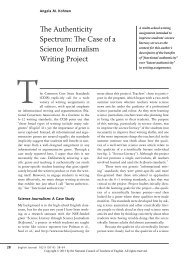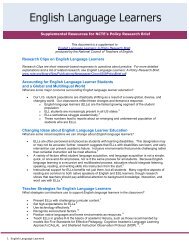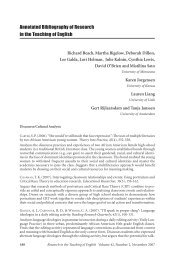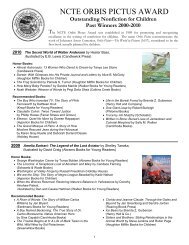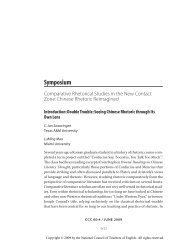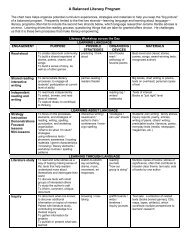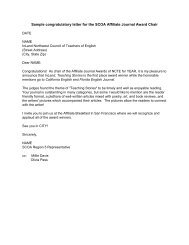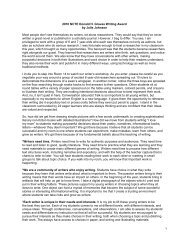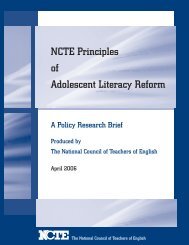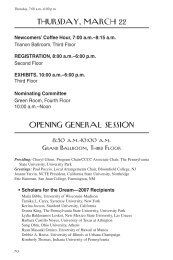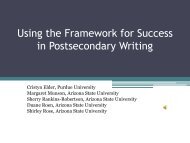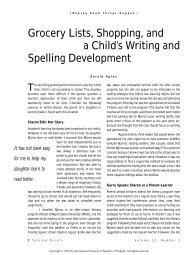Annotated Bibliography of Research in the Teaching of English
Annotated Bibliography of Research in the Teaching of English
Annotated Bibliography of Research in the Teaching of English
- No tags were found...
Create successful ePaper yourself
Turn your PDF publications into a flip-book with our unique Google optimized e-Paper software.
<strong>Annotated</strong> <strong>Bibliography</strong> 211KELLY, D., POMERANTZ, S., & CURRIE, D. (2005). Skater girlhood and emphasized fem<strong>in</strong><strong>in</strong>ity: “Youcan’t land an ollie properly <strong>in</strong> heels”. Gender and Education, 17(3), 229-248.LEE, C. (2006). “Every good-bye a<strong>in</strong>’t gone”: Analyz<strong>in</strong>g <strong>the</strong> cultural underp<strong>in</strong>n<strong>in</strong>gs <strong>of</strong> classroomtalk. International Journal <strong>of</strong> Qualitative Studies <strong>in</strong> Education, 19(3), 305-327.LIU, Y. (2005). The construction <strong>of</strong> pro-science and technology discourse <strong>in</strong> Ch<strong>in</strong>ese languagetextbooks. Language and Education 19(4), 304-321.MATSUBA, M., & WALKER, L. (2005). Young adult moral exemplars: The mak<strong>in</strong>g <strong>of</strong> self throughstories. Journal <strong>of</strong> <strong>Research</strong> on Adolescence, 15(3), 275-297.O’HALLORAN, S. (2005). Symmetry <strong>in</strong> <strong>in</strong>teraction <strong>in</strong> meet<strong>in</strong>gs <strong>of</strong> Alcoholics Anonymous: Themanagement <strong>of</strong> conflict. Discourse & Society, 16(4), 535-560.PAHL, K. (2004). Narratives, artifacts and cultural identities: An ethnographic study <strong>of</strong> communicativepractices <strong>in</strong> homes. L<strong>in</strong>guistics and Education, 15(4), 339-358.SFARD, A., & PRUSAK, A. (2005). Tell<strong>in</strong>g identities: In search <strong>of</strong> an analytic tool for <strong>in</strong>vestigat<strong>in</strong>glearn<strong>in</strong>g as a culturally shaped activity. Educational <strong>Research</strong>er, 34(4), 14-22.SOLOMON, P., PRTELLI, J., DANIEL, B., & CAMPBELL, A. (2005). The discourse <strong>of</strong> denial: How whiteteacher candidates construct race, racism, and “white privilege.” Race, Ethnicity, and Education,8(2), 147-169.STOUGHTON, E., & SIVERTSON, C. (2005). Communicat<strong>in</strong>g across cultures: Discursive challengesand racial identity formation <strong>in</strong> narratives <strong>of</strong> middle school students. Race, Ethnicity, and Education,8(3), 277-295.WHARTON, S. (2005). Invisible females, <strong>in</strong>capable males: Gender construction <strong>in</strong> a children’sread<strong>in</strong>g scheme. Language and Education, 19(3), 238-251.LiteracyBESWICK, J. F., WILLMS, J. D., & SLOAT, E. A. (2006). A comparative study <strong>of</strong> teacher rat<strong>in</strong>gs <strong>of</strong>emergent literacy skills and student performance on a standardized measure. Education, 126(1),116-137.Exam<strong>in</strong>es <strong>the</strong> discrepancy between assessment <strong>in</strong>formation derived from teacher rat<strong>in</strong>gs basedon observation checklists and standardized tests for 205 k<strong>in</strong>dergarten students <strong>in</strong> rural Canadato determ<strong>in</strong>e <strong>the</strong> degree to which contextual assessments are valid judgments about children’searly literacy skill development. Focuses on whe<strong>the</strong>r teacher rat<strong>in</strong>g-scale data were valid <strong>in</strong> relationto outcomes obta<strong>in</strong>ed on standardized measures, <strong>the</strong> extent to which <strong>the</strong>y were discrepant,and <strong>the</strong> variables that <strong>in</strong>fluenced <strong>the</strong> discrepancy between results obta<strong>in</strong>ed on <strong>the</strong> two measures.F<strong>in</strong>ds systematic discrepancy between teachers’ rat<strong>in</strong>g <strong>of</strong> students’ emergent literacy skillsand students’ performance on a standardized direct measure, discrepancies closely associatedwith child, family, student gender, and behavioral factors. Suggests <strong>the</strong> need for tra<strong>in</strong><strong>in</strong>g teachers<strong>in</strong> <strong>the</strong> validity <strong>of</strong> <strong>the</strong>se different measures, particularly <strong>in</strong> terms <strong>of</strong> variations <strong>in</strong> students’sociocultural backgrounds.BROOKS, G., MILES, J. N. V., TORGERSON, C. J., & TORGERSON, D. J. (2006). Is an <strong>in</strong>tervention us<strong>in</strong>gcomputer s<strong>of</strong>tware effective <strong>in</strong> literacy learn<strong>in</strong>g? A randomised controlled trial. EducationalStudies, 32(2), 133-143.Exam<strong>in</strong>es <strong>the</strong> effects <strong>of</strong> literacy learn<strong>in</strong>g delivered via laptop computers for 11- to 12-year-oldstudents. <strong>Research</strong>ers randomly assigned <strong>the</strong> 155 students to an ICT group or a control group.F<strong>in</strong>ds that us<strong>in</strong>g <strong>the</strong> computer did not lead to higher spell<strong>in</strong>g outcomes. For read<strong>in</strong>g, a reduction<strong>of</strong> students’ scores was found as a result <strong>of</strong> <strong>the</strong> ICT <strong>in</strong>tervention.FAULKNER, V. (2005). Adolescent literacies with<strong>in</strong> <strong>the</strong> middle years <strong>of</strong> school<strong>in</strong>g: A case study <strong>of</strong> ayear 8 homeroom. Journal <strong>of</strong> Adolescent & Adult Literacy, 49(2), 108-117.



